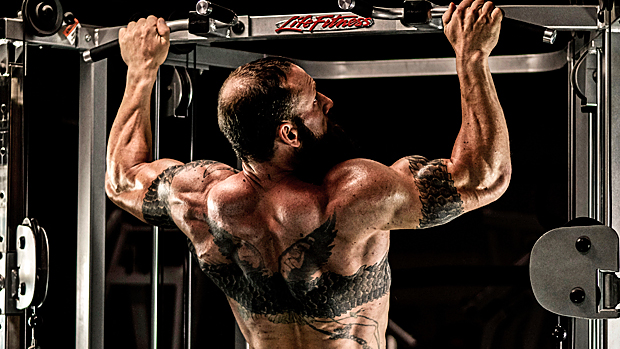The Ladder Method
Ladders are a training method that have a long history and can do wonders for your strength, power, and hypertrophy. The basic ladder is some variation of 1-2-3-4-5, using the same weight. It looks like this:
- One rep
- Rest
- Two reps
- Rest
- Three reps
- Rest
- Four reps
- Rest
- Five reps
The upside of constant weights is that it allows you to appreciate RPE, Rate of Perceived Exertion. If you did the 1-2-3-4-5 ladder with pull-ups, you'd find the one and two-rep sets to be relatively easy and the four and five-rep sets harder. Yes, that's common sense, but this method will teach you to change your RPE for many exercises and loads by coaxing the volume up without too much of a challenge.
This is important, because most people focus on making their max (100%) go up. That's fine and, in fact, admirable. Others, like former discus world record holder, John Powell, deal with the challenge of increasing strength and performance by coaxing their 80% of their 1RM up. That's the world in which ladders live. They're a different way of adding volume and they're a challenge for those who like "burn out" sets or finishers.
The Basic Ladder
This is the most basic ladder:
1-2-3-1-2-3-1-2-3
Do NOT increase the weight when going from three reps back to one. Yes, the single will be easy. You want that. It will feel light and "blow up" as you lift. This basic ladder gives us 18 total reps and that gets us pretty close to the lower range of the classic 20-30 reps necessary for hypertrophy and strength established by Delorme's research.
The most thought-challenging thing about ladders is rest periods. Many find the "I go/you go" method to be perfect. You rest as long as it takes your training partner to finish. Of course, rest periods may vary based on the number of reps in the previous set. You may need almost no time to recover for the single rep; you may need more time to recover to do the 3-rep set.

A Ladder for Presses and Squats
This ladder works well for bench presses and squats:
2-3-5-2-3-5-2-3-5
Or, you could do it this way, which is a variation of the classic 5 x 5 rep scheme. You just drop off the last set of 5 to get 25 total reps:
2-3-5-2-3-5-2-3
You can use a lot more load than the more traditional methods. The 2-3 sets are "easy" and the 5's are killers.
The Hypertrophy Ladder
For building muscle, especially in overhead pressing (one arm or two arm), this ladder works very well:
2-3-5-10
Just doing one round of that is 20 reps and it's very easy to march up to 100 total reps by going through it five times. Generally, two or three rounds are as much as most of us will need, though. Using constant weight, the progression will look like this:
2-3-5-10-2-3-5-10-2-3-5-10
The Whole Body Ladder Workout
You can use ladders for your entire workout, but you need some planning and thinking. Here's an example:
- Press: 2-3-5-2-3-5
- Deadlift: 1-2-3-1-2-3-1-2-3
- Squat: 2-3-5-2-3-5
- Curls: 1-2-3-1-2-3-1-2-3
Think three days a week and "autoregulate" the loads. In other words, increase the load when it start to feel easy!
The Rules of Ladders
Ladders are remarkably simple. Still, they have guidelines. Ladder expert Steve Shafley provides some rules:
- Focus on the big moves. Compound, multi-joint movements are best, but you can even do ladders with curls. Quick lifts, like the Olympic lifts, also work well with ladders as there's little fatigue.
- Pick your rep range. Taking your approximate 5 rep max and doing a ladder with 1-2-3 reps is a good place to start. Start light.
- Pick the number of times to run through the ladders. I'd suggest starting with three, though. If you get all three ladders, then you need to add weight next time.
- It's all about staying fresh and crisp. It's not about grinding out reps and gritting your teeth. Autoregulation is primary. There are no percentages, plans, or programs to figure out. The athlete needs to adjust the load by "feel."
- Let the volume do the work. This is often underappreciated. Getting strong, getting ripped, and getting massive takes time, energy, and effort. With strength, you need lots of clean reps with crisp technique to teach the nervous system to eventually lift massive loads.
- The speed of the load and the overall effort must be maintained throughout. If you want to grind out reps, ladders are NOT for you.
- Don't sweat bad days. Ladders seem to work from nervous system adaption. Like all systems, fixing the wiring might take some extra time.
Ladders build the foundation of heavy lifting. As Tom Platz taught us years ago: "It's not heavy weights that build muscle. It's not high reps that build muscle. It's high reps with heavy weights that build muscle."





